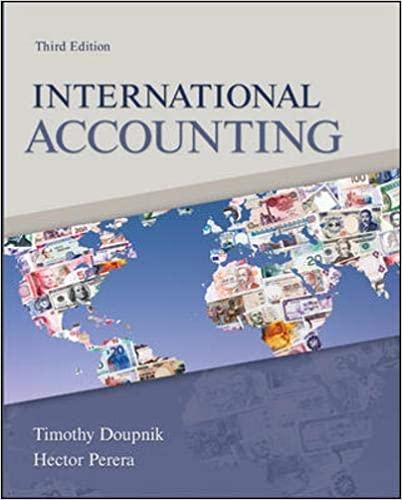Question
Comprehensive Problem Topp Manufacturing Company acquired 90 percent of Bussman Corporation?s outstanding common stock on December 31, 2005, for $1,332,000. At that date, the fair
Comprehensive Problem Topp Manufacturing Company acquired 90 percent of Bussman Corporation?s outstanding common stock on December 31, 2005, for $1,332,000. At that date, the fair value of the noncontrolling interest was $143,000, and Bussman reported common stock outstanding of $600,000, premium on common stock of $270,000, and retained earnings of $346,000. The book values and fair values of Bussman?s assets and liabilities were equal, except for land, which was worth $64,000 more than its book value. On April 1, 2006, Topp issued at par $400,000 of 10 percent bonds directly to Bussman; interest on the bonds is payable March 31 and September 30. On January 2, 2007, Topp purchased all of Bussman?s outstanding 10-year 12 percent bonds from an unrelated institutional investor at 98. The bonds originally had been issued on January 2, 2001, for 101. Interest on the bonds is payable December 31, and June 30. Since the date it was acquired by Topp Manufacturing, Bussman has sold inventory on account to Topp on a regular basis. The amount of such intercompany sales totaled $96,000 in 2006 and $117,000 in 2007, including a 40 percent gross profit. All inventory transferred in 2006 had been sold by December 31, 2006, except inventory which Topp paid $22,500 and did not resell until January 2007. All 2006 inventory transactions on account had been satisfied prior the end of the year. Inventory transferred in 2007 had been resold at December 31, 2007, except merchandise for which Topp had paid $27,000. An account balance of $43,500 remained unpaid on 2007 inventory transactions. On January 1, 2006, Bussman sold equipment to Topp for $72,000. Bussman had purchased the equipment for $135,000 on January 1, 2003, and was depreciating it on a straight-line basis with a 10-year expected life and no anticipated salvage value. The equipment?s total expected life is unchanged as a result of the intercompany sale. As of December 31, 2007, Bussman had declared but not yet paid its fourth-quarter dividend of $15,000. Both Topp and Bussman use straight-line depreciation and amortization, including the amortization of bond discount and premium. On December 31, 2007, Topp uses the basic equity method to account for its investment in Bussman 1. Prepare all eliminating entries required as of December 31, 2007 2. Prepare and complete a three-part workpaper for the preparation of consolidated financial statements for 2007 in good form. At December 31, 2007, trial balances for Topp and Bussman appeared as follows: Topp Manufacturing Bussman Corporation Item Debit Credit Debit Credit Cash 59,250 43,500 Current Receivables 168,750 127,600 Inventory 451,500 523,300 Investment in Bussman Stock 1,731,600 Investment in Bussman Bonds 1,477,500 Investment in Topp Bonds 400,000 Land 2,022,400 544,500 Building and Equipment 4,194,000 2,577,600 Cost of Goods Sold 3,013,500 645,000 Depreciation and Amortization 292,500 127,500 Other Expenses 964,500 309,000 Dividends Declared 75,000 60,000 Accumulated Depreciation 1,815,000 928,500 Current Payables 147,000 118,500 Bonds Payable 400,000 1,500,000 Premium on Bonds Payable 4,500 Common Stock 1,500,000 600,000 Premium on Common Stock 1,050,000 270,000 Retained Earnings, January 1 4,549,500 705,000 Sales 4,651,500 1,185,000 Other Income 202,500 46,500 Income from Subsidiary 135,000 Total 14,450,500 14,450,500 5,358,000 5,358,000
Step by Step Solution
There are 3 Steps involved in it
Step: 1

Get Instant Access to Expert-Tailored Solutions
See step-by-step solutions with expert insights and AI powered tools for academic success
Step: 2

Step: 3

Ace Your Homework with AI
Get the answers you need in no time with our AI-driven, step-by-step assistance
Get Started


